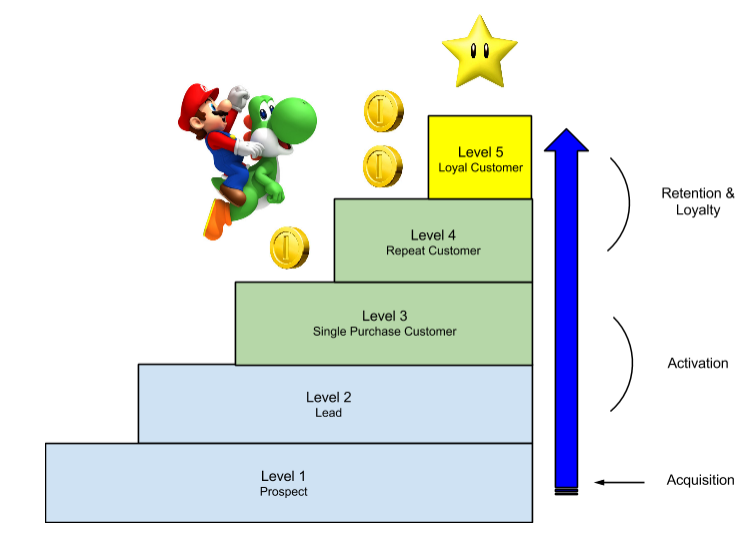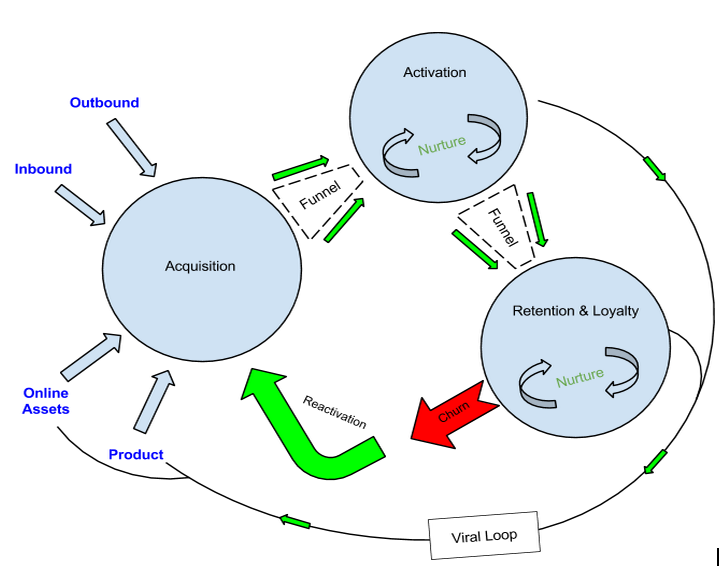This post covers customer lifecycle marketing, a vital strategy to maximise profitability for any ecommerce store.
It is intended for ecommerce marketeers, Heads of Ecommerce or anyone running an ecommerce store. You will learn the fundamentals and tactics behind becoming a lifecycle marketeer. Move forward with the skills necessary to increase revenues and customer satisfaction by targeting and nurturing customers effectively at every stage of development.
Customer lifecycle marketing (CLM) starts with creating the right thought process. I see too many retailers focused on optimising around conversions per website visit rather than the whole lifecycle.
The key to success in CLM is behind optimising for Customer Lifetime Value (CLV) and not conversion rate (CR) or revenue per visit (RPV). This is not to say conversion rate does has its place – it’s a very important metric in the right scenario. However the hierarchy is what is important. CLV trumps all others as a metric for long term profitability.
For those who are not familiar with the term, CLV can be defined as the total revenue received over the total lifetime of a customer. We are therefore optimising over the course of a customer’s relationship with your brand rather than at one point in time.
This leads on to the concept of the customer lifecycle machine which is made up of three different, but equally important, elements: Acquisition, Activation & Retention. These elements nurture and guide the behaviour of your visitors and customers in order to achieve specific goals, with the ultimate aim of increasing revenues based on maximising CLV. Throughout this process your visitors and customers will go through various stages of development, and understanding these stages is essential to creating the right sales and marketing machine. Before that, let’s have a quick break to see how important CLM is!
The importance of CLM
The above stats focus on repeat customers. Why? Because this is one of the ultimate goals of CLM: progressing, or as I like to call it ‘Leveling up’ customers through the different customer development stages. Which takes us on to…

Prospect – This encompasses all first time and repeat visitors who have not yet purchased from your online store or given you any details about them. I like to refer to this group as prospective customers, even though this may not be entirely true – someone could be visiting your job page for example. I believe it’s good practice to think of all your visitors as opportunities, as this encourages you to continually test new ideas to take advantage of these opportunities on a daily basis.
Lead – Leads are prospects who have performed a micro conversion, such as signing up to your blog, and giving you some personal information in the process. The most important information to gather is the email address. This information can then be used to market to them after they have left your site, and depending on the information you gathered you should also be able to market to them in a more relevant way. This step is not a requirement en route to becoming a customer, but it is a method to optimise the ‘prospect to customer’ conversion rate through nurturing.
Single Purchase Customer – Individuals who have completed their first transaction on your website.
Repeat Customer – Individuals who have made more than one transaction with you but are yet to become loyal customers.
Loyal Customer – Loyal customers will be defined slightly differently for different online stores. However as a guideline I like to say loyal customers are those that have completed more than 3 transactions, have been a customer for more than 6 months and have performed a transaction in the last x months. The x months should be relevant to your average sales cycle.
{{cta(‘cf95378b-d61d-4835-99ce-fe2ce2023791’)}}
Ok, we have covered the main stages of customer development, so now we can look at the system that guides and optimises the transition of your customers through each stage. The customer lifecycle machine is made up of three core elements:
Acquisition – Acquiring relevant traffic
Activation – Converting Customers
Retention – Encouraging retention & Minimising Churn

Relevant visitors refers to individuals who are likely to be interested in your product – your target market. This goal will also include a profitability target which will be calculated by comparing the cost of customer acquisition (CoCA) per channel in relation to customer lifetime value (CLV). This target will be manipulated based on a business’s current business model. If you are early stage and going through rapid growth you may be able to justify negative profitability on acquisition because the goal is simply to acquire customers until you reach a certain scale.
Acquiring prospects relies on a well structured marketing strategy that targets people at different stages of development through the buying cycle (Awareness, Research, Intent). I recommend utilising highly targeted marketing tactics in each of these four areas:
Acquiring prospects relies on a well structured marketing strategy that targets people at different stages of development through the buying cycle (Awareness, Research, Intent). I recommend utilising highly targeted marketing tactics in each of these four areas:
Blog, Ebooks, Free tools, Social, SEO, PR, Videos, Email.
Product acquisition tactics revolve around building virality into your products. This is not easy to pull off and only works in specific cases, but it can be incredibly rewarding. Take Diamond Candles as an example. Their product spread virally through word of mouth due to the free diamond ring you received with every candle. The friends of customers often commented on the rings and were subsequently made aware of diamond candles.They made their product into a marketing tool. A viral loop directly related to buying a product….you can’t really ask for much better.
Viral marketing built into your online assets: Website, Mobile site, App. A successful example of this is Gilt, whose ‘refer a friend’ scheme helped them to grow very quickly and get a big lead over their competitors.
The ratio of CoCA:CLV.
Traffic quantity
Cohort Analysis
Primary Goal – To convert Prospects and Leads into customers.
Secondary Goal – To convert prospects into Leads by gathering personal information such as their email, gender etc.
After new users have arrived on your site it’s all about activation, which is the process of turning prospects and leads into customers. Many people think that you need to activate visitors into customers straight away with a macro conversion – i.e. a transaction – however I advocate using a more long term strategy. It’s important to understand that many people need to be nurtured into customers, and you will need to foster engagement through micro conversions before going straight for the sale.
For example, people may need to learn the value behind your products and brand before converting. Try to focus on encouraging micro conversions that you know increase the likelihood of a prospect eventually becoming a customer. You can find this out through careful analysis of your customer behaviour data.
It is also very important at this stage to obtain someone’s email address so that you have the ability to market to them at a later stage. Without that information you have no way of individually targeting those individuals again until they come back of their own accord – which of course many will never do!
To improve average CLV. Always optimise for CLV and not ‘first purchase’ value. You want to know the value customers give you over their whole lifecycle, not just at one point in time. To improve average CLV you will need to nurture and encourage your customers to ‘level up’ through your customer development stages:
Find the behaviour which caused previous customers to become a repeat customer and optimise your site for it.
Convert repeat customers into loyal customers.
Find the behaviour which caused previous customers to become a loyal customer and optimise your site for it.
Improving Average CLV
Segment your customers by behaviour and create highly targeted marketing campaigns for specific segments of customers based on development stage and buyer persona. There are some personas that are relevant to the majority of online businesses, and others which will be specific to yours alone. It’s all about finding patterns of behaviour in your data. I’ve listed a few key segmentations below:
Your top 1% of customers can generate as much revenue as the bottom 50% combined. (RJmetrics).
It is very beneficial to focus on engaging and nurturing your best customers. I typically define ‘best’ as the top 1-2% of customers by CLV.
Give them special treatment and individually personalised marketing offers. Here are a few examples:
Evangelists
Empower & engage with evangelists – those individuals who have influence over relevant online and offline communities. Give them the tools necessary to promote your brand in order to encourage and easily facilitate word of mouth marketing.
Economical Customers
These customers have a tendency to only purchase when you offer steep discounts. It’s very important not to offer discounts too often, or too regularly, so as to prevent your customers become conditioned to always wait for the next deal. Having said that, there will always be price sensitive customers. Consider sending targeted offers just to this selection of people so you can obtain better margins from your less price sensitive customers.
Big but Infrequent Spenders
These individuals have a very high AOV value but purchase very infrequently. It is likely these individuals have a lot of disposable income. Send special promotions based on their purchase behaviour to try and gain a larger share of wallet.
New Customer
This stage is a combination of targeted marketing efforts and customer service and brand development. A mix of highly targeted personalisation and promotions with helpful, interesting, and brand-building content. You need to continually optimise throughout the buying cycle and take care of your best customers.
It’s all about customer segmentation. The ultimate goal would be for all your customers to be hero customers! However this defeats the point, as we know your hero customers are the top 1-2%. Therefore the goal is not to optimise for only hero customers, but for numerous different segmentations of valuable customers which make up your repeat and loyal customer base. Many customers will never become heros or evangelists, but enough will if nurtured properly. Optimise your average CLV by finding the behaviour, such as triggers and micro conversions, which funnel them towards your goals.
Again this will vary wildly based on your individual business, however I’ve listed some key metrics below.
CLV (By persona/development stage)
Single Purchase Customer to Repeat Customer conversion rate
Repeat Customer to Loyal Customer conversion rate
% monthly churn
Recency
Frequency
Engagement (Micro conversions)
Share of wallet
Cohort Analysis
Customer Segmentation
Thanks for reading – f you enjoyed this post, please sign up to our blog or newsletter for more related content.
Thanks,
Ed @edgotham
{{cta(‘9d574c3e-b22c-4692-b853-1eccd56b2113’)}}
Ometria is committed to protecting and respecting your privacy, and we’ll only use your personal information to administer your account and to provide the products and services you requested from us. You may unsubscribe from these communications at any time. For information on how to unsubscribe, as well as our privacy practices and commitment to protecting your privacy, please review our Privacy Policy.
Take the first step toward smarter customer marketing